
Publius Licinius Egnatius Gallienus was Roman emperor with his father Valerian from 253 to 260 and alone from 260 to 268. He ruled during the Crisis of the Third Century that nearly caused the collapse of the empire. He won numerous military victories against usurpers and Germanic tribes, but was unable to prevent the secession of important provinces. His 15-year reign was the longest in half a century.
The 260s decade ran from January 1, 260, to December 31, 269.
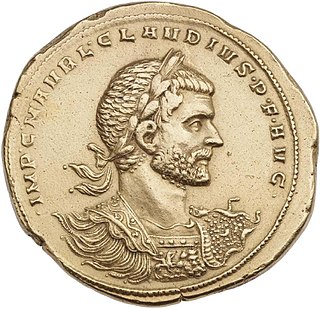
Marcus Aurelius Claudius "Gothicus", also known as Claudius II, was Roman emperor from 268 to 270. During his reign he fought successfully against the Alemanni and decisively defeated the Goths at the Battle of Naissus. He died after succumbing to a "pestilence", possibly the Plague of Cyprian that had ravaged the provinces of the Empire.

The Gallic Empire or the Gallic Roman Empire are names used in modern historiography for a breakaway part of the Roman Empire that functioned de facto as a separate state from 260 to 274. It originated during the Crisis of the Third Century, when a series of Roman military leaders and aristocrats declared themselves emperors and took control of Gaul and adjacent provinces without attempting to conquer Italy or otherwise seize the central Roman administrative apparatus.

Marcus Cassianius Latinius Postumus was a Roman commander of Batavian origin, who ruled as emperor of the splinter state of the Roman Empire known to modern historians as the Gallic Empire. The Roman army in Gaul threw off its allegiance to Gallienus around the year 260, and Postumus assumed the title and powers of Emperor in the provinces of Gaul, Germania, Britannia, and Hispania. He ruled for the better part of ten years before he was murdered by his own troops.

Legio XIV Gemina was a legion of the Imperial Roman army, levied by Julius Caesar in 57 BC. The cognomen Gemina (Twinned) was added when the legion was combined with another understrengthed legion after the Battle of Actium. The cognomen Martia Victrix was added following their service in the Pannonian War c. AD 9 and the defeat of Boudicca in AD 61. The emblem of the legion was the Capricorn, as with many of the legions levied by Caesar.
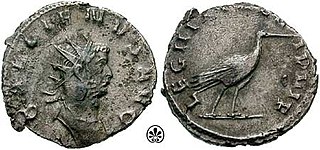
Legio III Italica was a legion of the Imperial Roman army founded in 165 AD by the emperor Marcus Aurelius for his campaign against the Marcomanni tribe. The cognomen Italica suggests that the legion's original recruits were drawn for the defence of Italy. The legion was still active in Raetia and other provinces in the early 5th century.

Gaius Pius Esuvius Tetricus was a Gallo-Roman nobleman who ruled as emperor of the Gallic Empire from 271 to 274 AD. He was originally the praeses of Gallia Aquitania and became emperor after the murder of Emperor Victorinus in 271, with the support of Victorinus's mother, Victoria. During his reign, he faced external pressure from Germanic raiders, who pillaged the eastern and northern parts of his empire, and the Roman Empire, from which the Gallic Empire had seceded. He also faced increasing internal pressure, which led him to declare his son, Tetricus II, caesar in 273 and possibly co-emperor in 274, although this is debated. The Roman emperor Aurelian invaded in 273 or 274, leading to the Battle of Châlons, at which Tetricus surrendered. Whether this capitulation was the result of a secret agreement between Tetricus and Aurelian or that surrender was necessary after his defeat is debated. Aurelian spared Tetricus, and made him a senator and the corrector (governor) of Lucania et Bruttium. Tetricus died of natural causes a few years after 274.
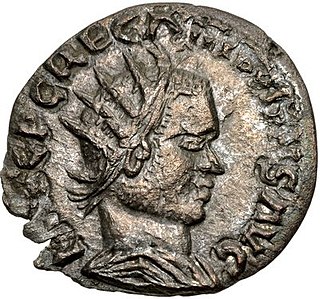
P. C. Regalianus, also known as Regalian, was Roman usurper for a few months in 260 and/or 261, during the Crisis of the Third Century, a period of intense political instability in the Roman Empire. Regalianus was acclaimed emperor by the troops along the Danube river, a region of the empire that frequently experienced barbarian raids, probably in the hope that he might be able to secure the frontier.

Lucius Mussius AemilianussignoAegippius was a Roman who held a number of military and civilian positions during the middle of the third century. He is best known as a Roman usurper during the reign of Gallienus.
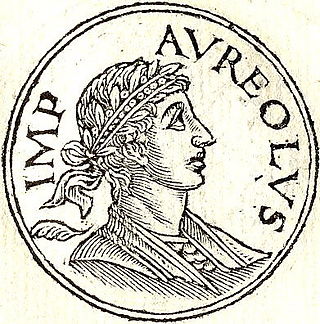
Aureolus was a Roman military commander during the reign of Emperor Gallienus before he attempted to usurp the Roman Empire. After turning against Gallienus, Aureolus was killed during the political turmoil that surrounded the Emperor's assassination in a conspiracy orchestrated by his senior officers. Aureolus is known as one of the Thirty Tyrants and is referenced in ancient sources including the Historia Augusta, Zonaras' epitome and Zosimus' Historia Nova.
The Gallienus usurpers were the usurpers who claimed imperial power during the reign of Gallienus. The existence of usurpers during the Crisis of the Third Century was very common, and the high number of usurpers fought by Gallienus is due to his long rule; fifteen years being considered long by the standards of the 3rd century Roman Empire.

Augusta Treverorum was a Roman city on the Moselle River, from which modern Trier emerged.
Silvanus was a Roman soldier and probably praetorian prefect during the third century who came briefly to the notice of history in the reign of Valerian and his co-Emperor Gallienus. He is generally assumed to have been the commander of the praetorians under Gallienus.

In the Historia Augusta, Postumus the Younger figures as one of the so-called Thirty Tyrants who usurped power against the Roman Emperor Gallienus. According to the pseudo-historical list of 'Thirty Tyrants', the Emperor of the Gallic Empire Postumus had a son, also called Postumus, whom he nominated to be first caesar, and later even augustus and co-ruler. Postumus the Younger would have been killed together with his father in 268, during the rebellion of Laelianus.
GaiusCassius Regallianus was a Roman senator active around AD 200. He was appointed consul suffectus in 202 as the colleague of Titus Murenius Severus.
Publius Cornelius Saecularis was a Roman politician who was appointed consul twice, first in around AD 240 and later in AD 260, during the Crisis of the Third Century.
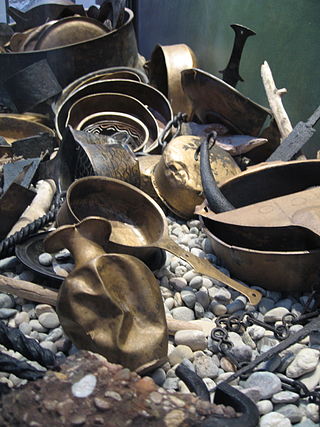
The Limesfall is the name given to the abandonment of the Upper Germanic-Rhaetian Limes in the mid-3rd century AD by the Romans and the withdrawal of imperial troops from the provinces on the far side of the rivers Rhine and Danube to the line of those rivers. It is sometimes called the fall of the limes.

The barbarian invasions of the third century (212-305) constituted an uninterrupted period of raids within the borders of the Roman Empire, conducted for purposes of plunder and booty by armed peoples belonging to populations gravitating along the northern frontiers: Picts, Caledonians, and Saxons in Britain; the Germanic tribes of Frisii, Saxons, Franks, Alemanni, Burgundians, Marcomanni, Quadi, Lugii, Vandals, Juthungi, Gepids and Goths, the Dacian tribes of the Carpi and the Sarmatian tribes of Iazyges, Roxolani and Alans, as well as Bastarnae, Scythians, Borani and Heruli along the Rhine-Danube rivers and the Black Sea.
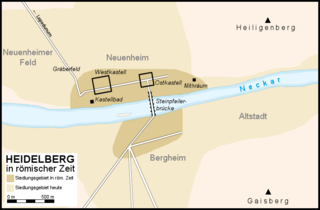
During ancient Rome, a settlement of unknown name existed at the site of Heidelberg. It consisted of a fort founded around 70 AD in the present-day district of Neuenheim and a civilian settlement (vicus) that developed around the fort and also extended into the present-day district of Bergheim. The original wooden military camp was replaced by a stone fort around the year 90. In 80/90 there was a wooden bridge over the Neckar, and in 200 there was a bridge built on stone pillars. Even after the garrison of the Heidelberg fort was withdrawn around the year 135, the civilian settlement continued to flourish thanks to its favorable geographical location and developed into a prosperous pottery center. Nevertheless, Heidelberg always remained in the shadow of neighboring Lopodunum, which was the main city of the region at the time. As a result of the Alamanni invasions, Roman Heidelberg was abandoned in the 3rd century as part of the so-called Limesfall.
















